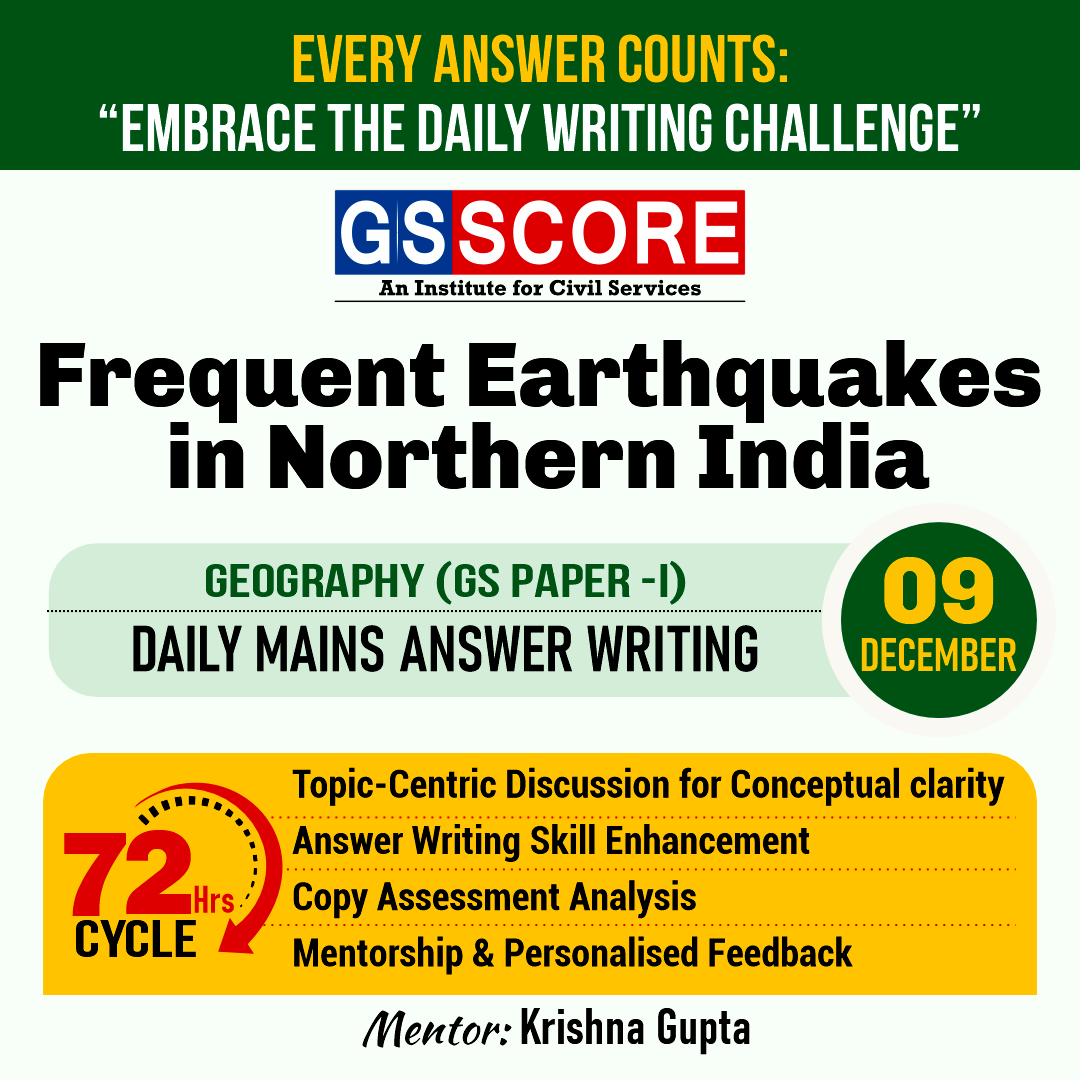


Instruction:
- There will be 2 questions carrying the First Question is-10 marks Write your answers in 150 words and the Second Question is-15 marks Write your answers in 250 words.
- Any page left blank in the answer-book must be crossed out clearly.
- Evaluated Copy will be re-uploaded on the same thread after 2 days of uploading the copy.
- Discussion of the question and one to one answer improvement session of evaluated copies will be conducted through Google Meet with concerned faculty. You will be informed via mail or SMS for the discussion.
Question #1. What are the specific geographical features or tectonic plate interactions that contribute to the frequent occurrence of earthquakes in northern India? 10 marks (150 words)
Question #2. Examine the significance of identification of High Seismic risk zone in Himalayan region in India? 15 marks (250 words)
(Examiner will pay special attention to the candidate's grasp of his/her material, its relevance to the subject chosen, and to his/ her ability to think constructively and to present his/her ideas concisely, logically and effectively).
STEPS & INSTRUCTIONS for uploading the answers
Step 1 - The Question for the day is provided below these instructions. It will be available at 7:00 AM.
Step 2 - Uploading of Answers : Write the answer in A4 Sheet leaving proper margins for comments and feedback and upload the PDF in MY ACCOUNT section. Click on the option of SUBMIT COPY to upload the PDF.
Step 3 - Deadline for Uploading Answers: The students shall upload their answers by 7:00 PM in the evening same day. The first 50 copies will be evaluated.
Step 4 - Feedback : Mentors will give their feedback for the answers uploaded. For more personalised feedback, join our telegram channel by clicking on the link https://t.me/mains_answer_writing_cse . A one-to-one session will be conducted with the faculty after copy evaluation in 72 Hrs.
Model Answer
Question #1. What are the specific geographical features or tectonic plate interactions that contribute to the frequent occurrence of earthquakes in northern India? 10 marks (150 words)
Ans
Northern India is situated in a seismically active region primarily due to the complex tectonic interactions between the Indian and Eurasian plates. Several geographical features contribute to the frequent occurrence of earthquakes in this area.
- Tectonic Plate Boundaries:Northern India is located at the convergent boundary where the Indian plate collides with the Eurasian plate. The collision is a result of the ongoing tectonic process known as the Himalayan orogeny. This convergence has led to the uplift of the Himalayan mountain range and the Tibetan Plateau. For e.g. The devastating 2015 earthquake in Nepal, which also affected northern India, was a result of the ongoing convergence between the Indian and Eurasian plates. The earthquake highlighted the vulnerability of the region to seismic events.
- Himalayan Thrust Fault System:The Himalayan region is characterized by a complex network of thrust faults, where the Indian plate is thrust under the Eurasian plate. This leads to intense seismic activity along these fault lines.
Case Study: The 2005 Kashmir earthquake, with its epicenter near Muzaffarabad in Pakistan-administered Kashmir, demonstrated the impact of thrust faulting in the region. The earthquake caused widespread destruction in northern India, emphasizing the seismic vulnerability of the area.
- Soft Sedimentary Basins:Certain regions in Shiwalik Himalayas consists of soft sedimentary basin which is frequently deformed and results in the seismic activities due to the movement of Indian Plate towards Eurasian plate.
For e.g. The 2001 Bhuj earthquake in Gujarat, though not in northern India, showcased the amplification effects of soft sediments. The seismic waves traveled across the Indo-Gangetic plain, affecting distant regions including northern India.
- Regional Fault Systems:Apart from the main Himalayan thrust fault, there are numerous subsidiary fault systems contributing to seismic activity in northern India. These faults add complexity to the tectonic landscape.
Case Study: The Uttarakhand earthquake of 1991 demonstrated the influence of regional fault systems. The event was associated with the Main Boundary Thrust fault, illustrating the varied sources of seismic activity in the region.
- River Systems and Erosion:The erosion caused by major river systems, such as the Ganges and its tributaries, plays a role in shaping the landscape. This erosion can affect the stability of the Earth's crust. For e.g. The Brahmaputra River, flowing through northeasternIndia, has been associated with seismic hazards. The erosion along its course can influence the stress distribution in the region, contributing to seismic activity.
The frequent earthquakes in northern India are a consequence of the intricate tectonic interactions, the presence of multiple fault systems, and the geological characteristics of the region. Understanding these factors is crucial for assessing and mitigating the seismic risks in this geographically sensitive area.
Question #2. Examine the significance of identification of High Seismic risk zone in Himalayan region in India? 15 marks (250 words)
Ans
The identification of high seismic risk zones in the Himalayan region in India is of paramount importance due to the inherent geological and tectonic complexities that make the area prone to earthquakes. This seismic risk assessment serves as a foundation for effective disaster preparedness, risk mitigation strategies, and the development of resilient infrastructure. Examining the significance involves understanding the potential consequences of earthquakes, the vulnerability of the population and structures, and the necessity for informed urban planning and construction practices.
- Population Vulnerability:The Himalayan region is densely populated, with numerous towns and cities located in areas prone to seismic activity. Identifying high seismic risk zones allows authorities to assess the potential impact on human settlements and plan for evacuation routes, emergency shelters, and medical facilities.
For e.g. The 2015 Nepal earthquake had a significant impact on densely populated areas, including Kathmandu. The identification of seismic risk zones is crucial to developing strategies for managing and safeguarding the population in the event of a similar earthquake in the Indian Himalayan region.
- Structural Vulnerability:Understanding seismic risk helps in evaluating the vulnerability of buildings and infrastructure. Identifying high-risk zones enables the formulation and enforcement of building codes and construction practices that enhance the seismic resilience of structures.
Case Study 1: Uttarakhand, India (1991 Uttarkashi Earthquake) TheUttarkashi earthquake revealed the vulnerability of structures in the region. Many buildings collapsed, leading to casualties and extensive damage. This event prompted a reevaluation of building codes and construction practices in the Himalayan region.
Case Study 2: Gujarat, India (2001 Bhuj Earthquake) While not in the Himalayan region, the Bhuj earthquake underscored the importance of seismic-resistant construction. Buildings in Gujarat were not adequately designed to withstand the seismic forces, resulting in widespread destruction. The lessons learned from this event are applicable to seismic risk zones across India.
- Infrastructure Planning and Resilience:The identification of high seismic risk zones informs urban and infrastructure planning. Authorities can prioritize retrofitting of critical infrastructure such as hospitals, schools, and bridges, ensuring that these structures can withstand the forces exerted during an earthquake.
For e.g. The retrofitting of critical infrastructure in Tokyo, Japan, a region with high seismic risk, has been instrumental in minimizing the impact of earthquakes. Similar proactive measures can be taken in the Himalayan region to enhance the resilience of essential facilities.
- Emergency Response Preparedness:Seismic risk assessment allows for the development of robust emergency response plans. Identifying high-risk zones enables authorities to strategically position emergency response teams, deploy resources, and establish communication networks to ensure a swift and effective response in the aftermath of an earthquake.
For e.g. Japan's earthquake early warning system has proven effective in providing prompt alerts to the population, allowing for timely evacuation and reducing casualties. Implementing a similar system in the Himalayan region can enhance preparedness and response capabilities.
- Community Awareness and Education:The identification of high seismic risk zones is a crucial component of community awareness and education programs. Local residents need to be informed about the seismic risks they face, the importance of preparedness measures, and evacuation procedures in the event of an earthquake.
For e.g. Community-based earthquake preparedness programs in California, USA, have increased public awareness and education, empowering residents to take proactive measures for earthquake safety. Similar initiatives can be implemented in the Himalayan region to build resilience at the community level.
- Insurance and Risk Mitigation Strategies:Insurance companies and policymakers rely on seismic risk assessments to develop risk mitigation strategies. Identifying high-risk zones helps in the formulation of insurance policies that consider the specific risks associated with seismic activity, encouraging individuals and businesses to invest in protective measures.
For e.g. In earthquake-prone regions such as California, earthquake insurance is tailored to the specific risks faced by property owners. The development of similar insurance products in the Himalayan region can incentivize risk reduction measures.
- Scientific Research and Monitoring:Seismic risk assessment involves continuous scientific research and monitoring of fault lines, stress accumulation, and other geological factors. This ongoing research is critical for improving our understanding of seismic hazards, allowing for the refinement of risk models and the development of more accurate predictions.
Case Study: Geological Survey of India (GSI) Seismic Zonation Map The GSI's seismic zonation maps for different regions in India, including the Himalayan region, provide valuable information for seismic risk assessment. These maps are essential tools for scientists, policymakers, and engineers involved in earthquake preparedness and mitigation efforts.
The identification of high seismic risk zones in the Himalayan region is instrumental in safeguarding the population, protecting infrastructure, and promoting sustainable development. Through a multidimensional approach that includes community education, infrastructure resilience, and scientific research, the region can better prepare for and mitigate the impact of earthquakes, ultimately saving lives and minimizing economic losses.

